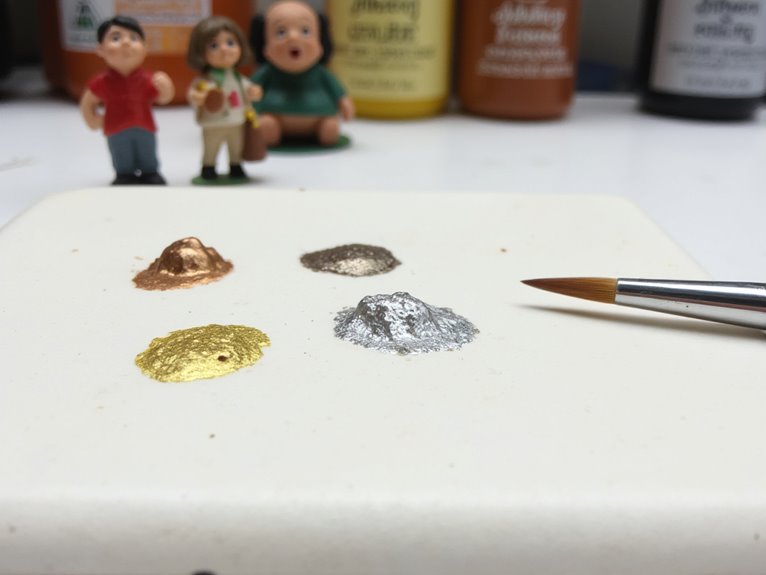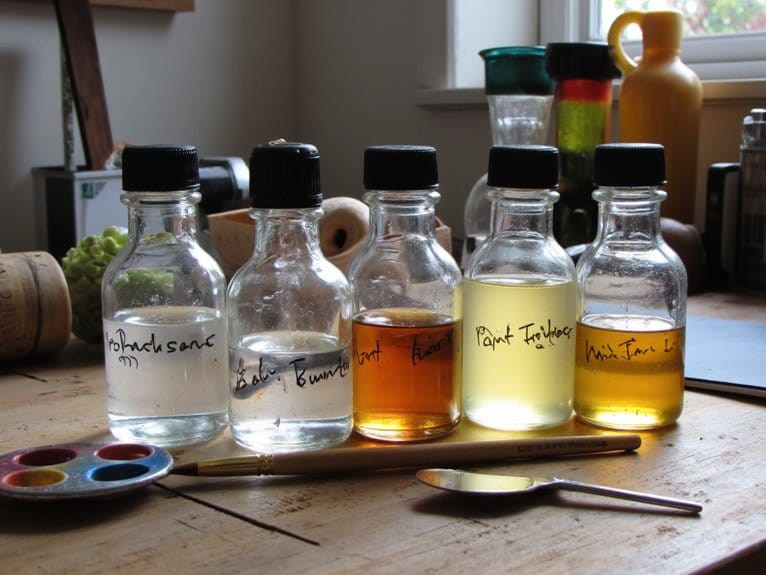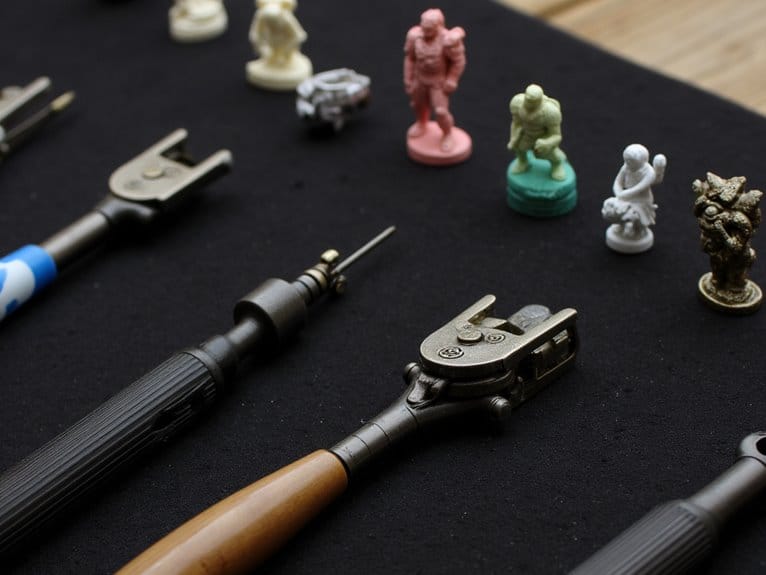We are supported by our audience. When you purchase through links on our site, we may earn an affiliate commission, at no extra cost for you. Learn more. Last update on 1st July 2025 / Images from Amazon Product Advertising API.
A dry palette uses a non-porous surface like glass, ceramic, or plastic that accelerates paint drying during miniature painting sessions. You’ll work with faster drying times that force efficient decision-making while maintaining precise control over paint consistency and application. The surface prevents moisture absorption, keeping your paint’s original binder-to-pigment ratio intact for predictable results. It’s particularly effective for dry brushing, edge highlighting, and metallic applications where moisture control matters. Understanding proper material selection and technique optimization will maximize your painting performance.
Notable Insights
- A dry palette is a non-porous surface like ceramic, glass, or plastic used for mixing paints in miniature painting.
- It accelerates paint drying which encourages quick decision-making and efficient workflow during painting sessions.
- Dry palettes excel at techniques like dry brushing, edge highlighting, and metallic paint applications due to moisture control.
- They maintain precise paint consistency by preventing water migration and preserving the original binder-to-pigment ratio.
- Easy cleanup and maintenance make dry palettes ideal for speed painting and batch painting multiple miniatures.
Understanding the Basic Concept of Dry Palettes
Although wet palettes dominate many miniature painting discussions, dry palettes remain the foundation of controlled, precise painting techniques.
You’re working with a non-porous surface that won’t introduce unwanted moisture into your paint.
Common dry palette types include plastic sheets, ceramic tiles, wood surfaces, and textured materials designed specifically for miniature painting.
These palettes accelerate paint drying, forcing you to work efficiently and make quick decisions.
You’ll load paint directly onto the surface for immediate paint application.
The dry environment prevents unpredictable paint flow that can compromise detail work. Dry palettes maintain a stable surface, which is essential for advanced techniques.
This makes dry palettes ideal for techniques like dry brushing, edge highlighting, and metallic applications where moisture control is critical for achieving professional results. Simple alternatives like milk carton caps and craft paint caps provide effective blending surfaces for budget-conscious painters.
Core Characteristics That Define Dry Palette Systems
A dry palette‘s fundamental architecture centers on its non-absorbent surface composition, which determines every aspect of your painting experience.
Your palette selection directly impacts paint behavior and control precision. Surface materials fall into three primary categories: coated paper, ceramic, and engineered plastics.
Coated paper provides disposable convenience but sacrifices durability. Block format dry palettes like Citadel’s version typically contain approximately 50 sheets for extended use sessions.
Ceramic and porcelain deliver superior longevity with easy cleaning capabilities. These materials maintain ideal paint consistency by preventing moisture absorption that would alter binder-to-pigment ratios. Ceramic flower palettes offer aesthetic appeal but come with higher cost considerations for budget-conscious painters.
The texture specification remains vital—smooth surfaces enable precise paint pickup while slightly textured variants slow drying without introducing unwanted moisture.
Surface texture controls paint behavior—smooth finishes optimize precision while subtle texture extends working time without compromising paint integrity.
This controlled environment preserves heavy paints and metallics while supporting advanced techniques like dry brushing and two-brush blending through consistent paint viscosity maintenance. Unlike wet palettes that maintain paint workability for 8+ hours, dry palettes require more frequent paint application due to faster drying times.
Key Advantages for Miniature Painting Applications
When you choose a dry palette for miniature painting, you’ll immediately notice three distinct performance advantages that directly impact your painting results.
The accelerated workflow and enhanced efficiency come from rapid paint drying that eliminates waiting periods between color applications and layers.
Your paint control becomes more precise and predictable, while specific techniques like dry brushing and metallic application perform at their best on moisture-free surfaces. Layering techniques benefit significantly from dry palette surfaces as they prevent unwanted color bleeding between applications. The glazed porcelain construction allows for quick cleanup with water after each painting session.
Speed and Efficiency Gains
Because dry palettes force paint to set quickly on their surface, they create an immediate pressure that transforms your painting workflow into a more decisive and efficient process.
Your palette selection directly impacts application techniques, as the rapid drying eliminates hesitation and reduces overthinking during sessions.
This accelerated workflow provides several key advantages:
- Faster decision-making – Quick paint drying forces immediate color choices and brush techniques
- Reduced downtime – No waiting for paint to remain workable compared to wet palette systems
- Efficient short bursts – Perfect for speed painting projects requiring rapid color application
- Batch painting optimization – Minimizes mixing overhead when painting multiple miniatures simultaneously
- Consistent momentum – Limited paint quantity necessitates focused brushwork without session interruptions
You’ll eliminate rehydration distractions and maintain steady painting rhythm throughout your entire session. While dry palettes excel in speed applications, wet palettes like the RGG systems are specifically designed for miniature painting situations where extended working time proves more valuable than rapid execution.
Superior Paint Control
Although wet palettes dominate many painting discussions, dry palettes deliver unmatched precision and stability that’s particularly valuable for advanced miniature techniques.
You’ll maintain perfect color integrity because paints retain their intended binder-to-pigment ratios without water interference. This consistency proves critical for paint layering where each coat must maintain specific opacity levels.
Dry palettes eliminate capillary moisture action that causes unpredictable paint flow. You can execute precise dry brushing techniques without worrying about moisture diluting your metallic paints or creating unwanted streaks.
Heavy paints maintain their structural integrity, preserving texture and reflectivity essential for realistic armor effects. Two-brush blending techniques work more effectively on dry palettes where you can control the exact paint thickness for each application.
You control paint consistency through deliberate mixing with additives rather than relying on variable moisture levels. This manual control enables tailored viscosity adjustments for specific blending techniques while preventing the color shifts common in fluctuating humidity conditions.
Technique-Specific Performance Benefits
Precision techniques demand consistent paint behavior that dry palettes deliver through their stable surface chemistry.
You’ll achieve superior dry brushing results because the palette removes excess moisture from your brush, preventing streaky application and dusty texture buildup. Heavy body paints and metallics maintain their structural integrity without water interference skewing their performance characteristics.
Your palette maintenance becomes simpler compared to wet palette systems that require constant monitoring. The controlled drying rates support advanced blending techniques like Two Brush Blending, where timing is critical.
Throughout dry palette history, painters have relied on these surfaces for specialty mediums that can’t tolerate moisture contamination.
- Eliminates pigment separation in heavy body acrylics
- Prevents moisture from compromising metallic paint flow
- Maintains specialty medium chemical balance
- Supports precise highlight application without streaking
- Enables consistent dry brushing texture definition
How Paint Behaves Differently on Dry Surfaces
When you place acrylic paint on a dry palette surface, the paint’s water content evaporates at a controlled rate, creating faster drying times that give you precise working windows.
Your paint maintains its original binder-to-pigment ratio without external moisture interference, resulting in stable consistency that won’t unexpectedly thin or thicken during application.
You’ll gain complete control over moisture levels since dry surfaces eliminate water migration from below, preventing the unpredictable paint flow changes that wet palettes can introduce.
Faster Drying Times
Unlike wet palettes that extend working time through moisture retention, dry palettes accelerate paint drying dramatically by eliminating the humid environment that normally slows evaporation.
You’ll notice acrylic paints lose water content within minutes rather than hours, forcing rapid decision-making during application. Environmental factors like temperature and humidity directly impact drying rates, with warm, dry conditions reducing paint lifespan to mere minutes on non-porous surfaces.
This accelerated timeline demands efficient paint storage techniques and pre-planned color sequences. You can’t adjust mixtures leisurely—hesitation results in unusable, dried paint requiring fresh applications.
Key considerations for faster drying times:
- Work in smaller paint quantities to minimize waste
- Plan color mixing sequences before starting
- Apply paints immediately after loading brushes
- Monitor environmental conditions affecting evaporation rates
- Prepare backup paint amounts for extended sessions
Stable Paint Consistency
While wet palettes introduce variable moisture that can compromise paint integrity, dry surfaces maintain acrylic paint in its intended formulation without dilution or separation. Your paint’s pigment-to-binder ratio stays constant, ensuring maximum paint stability throughout extended sessions. This consistency prevents the structural breakdown that occurs when excess moisture weakens paint formulations.
Dry palettes deliver superior color retention by maintaining pigment concentration at manufacturer specifications. Without moisture migration altering your paint’s chemistry, you’ll achieve predictable application characteristics and uniform coverage. The stable surface prevents pooling and unwanted flow changes.
| Paint Property | Dry Palette | Wet Palette |
|---|---|---|
| Pigment concentration | Maintains original ratio | Dilution occurs |
| Brush control | Precise pickup | Variable consistency |
| Coverage strength | Full intensity | Potentially weakened |
| Edge definition | Sharp, controlled | Soft, flowing |
| Session predictability | Consistent behavior | Changing properties |
This stability enables precise layering and detail work essential for miniature painting excellence.
Controlled Moisture Levels
Moisture control becomes critical during paint application because dry palettes eliminate the unpredictable water migration that compromises your brush control.
You’ll achieve superior moisture balance when paint maintains its intended consistency without external water interference. This controlled environment prevents unwanted thinning that creates streaking and bathtub rings on your miniatures.
Paint retention improves greatly on dry surfaces because pigments stay properly suspended without dilution.
Your heavy-bodied acrylics and metallic paints perform at their best when their polymer ratios remain intact. The absence of capillary action means paint flows exactly as formulated by manufacturers.
- Eliminates unpredictable paint flow and unwanted thinning during application
- Prevents streaking and bathtub ring formation on miniature surfaces
- Maintains proper polymer and pigment ratios in specialty paints
- Reduces pigment separation for consistent vibrancy and coverage
- Enables predictable paint behavior for precise technique execution
Technical Considerations for Optimal Performance
When selecting a dry palette for miniature painting, the surface material directly impacts your paint’s behavior and overall painting performance. Different dry palette types offer distinct advantages: ceramic provides moderate durability but risks breakage, plastic resists damage but may retain paint residue, and disposable paper eliminates cleanup but creates waste.
Glass palettes deliver superior performance through their non-porous surface, enabling complete paint removal without contamination between sessions.
Palette maintenance varies greatly by material choice. Glass surfaces require simple soap and water cleaning, while plastic palettes may need solvent scrubbing to remove stubborn paint films.
Paper palettes eliminate maintenance entirely but increase ongoing costs. The flat, non-absorbent surface characteristic of quality dry palettes guarantees consistent paint viscosity and brush loading behavior, directly affecting your technique execution and color accuracy throughout extended painting sessions.
Speed Painting Benefits and Fast Decision Making
When you’re working with a dry palette, the accelerated paint drying forces you to make faster brushwork decisions and develops your technical skills under time pressure.
You’ll find that the reduced working time eliminates hesitation and overthinking, pushing you to commit to brush strokes with greater confidence and precision.
This constraint trains your muscle memory and decision-making speed, transforming what initially feels rushed into controlled, efficient painting techniques.
Quick Paint Drying Forces
Unlike wet palettes that maintain paint workability for extended periods, dry palettes accelerate the drying process dramatically, creating a natural time pressure that transforms your painting approach. This forced acceleration eliminates hesitation and second-guessing during application.
You’ll develop instinctive color choices and decisive brushwork as the quick drying demands immediate commitment to each stroke. The rapid drying forces you to pre-plan color schemes before touching brush to miniature.
Quick application becomes essential, pushing you toward efficient paint methods that maximize coverage while minimizing rework opportunities.
- Eliminates overthinking – Fast drying prevents endless adjustments and reworking
- Develops muscle memory – Repeated quick decisions improve brush control speed
- Reduces paint waste – Short working times encourage efficient paint usage
- Builds confidence – Forced commitment strengthens decision-making skills
- Prevents overworking – Natural time limits stop color muddying
Rapid Brushwork Development
Three critical skills emerge simultaneously when dry palettes force rapid brushwork development: precise brush control under time pressure, instinctive color application, and confidence in permanent stroke placement.
Your hand-eye coordination improves dramatically when racing against drying paint. You’ll develop smooth, deliberate strokes because hesitation means wasted paint and time. This pressure-cooker environment builds muscle memory faster than traditional slow techniques.
Rapid brush technique practice transforms your color selection process from cautious deliberation to confident execution. You’ll learn to load proper paint amounts on your first attempt, eliminating multiple dips that slow workflow. Quick tonal changes become second nature as you master brush pressure variations.
Speed painting creates natural stroke habits without overthinking. Your brushwork becomes fluid and continuous rather than choppy and uncertain. Each painting session reinforces decisive application techniques that translate into overall skill improvement.
Two Brush Blending Techniques With Dry Palettes
Two brush blending (2BB) represents one of the most effective techniques for achieving smooth color shifts on miniatures when paired with a dry palette. This approach uses one brush for paint application and a second blending brush to soften shifts.
Two brush blending paired with dry palettes delivers superior color transitions through dedicated application and blending brush roles.
The dry palette maintains ideal paint consistency without moisture management complications found in wet palettes, preserving pigment integrity and enabling precise paint control.
Your application methods involve depositing small paint amounts directly from the palette, then immediately blending while the acrylic paints remain workable. Surface texture on dry palettes regulates paint flow, preventing the blending errors that occur with inconsistent moisture levels.
When selecting paints for this technique, focus on ready-to-spray formulas that eliminate mixing complications and provide consistent flow characteristics essential for seamless blending transitions.
- Load paint dots directly onto dry palette for immediate brush techniques
- Apply paint with first brush, blend immediately with clean second brush
- Maintain consistent paint consistency through proper palette maintenance
- Layer thin applications to build smooth shift effects gradually
- Practice with specialty paints requiring intact binder-to-pigment ratios
Dry Brushing Mastery and Texture Control
Dry brushing transforms your miniature painting approach by demanding precise paint consistency and controlled application methods that dry palettes naturally support.
The dry palette benefits include maintaining ideal paint viscosity without unwanted moisture that compromises pigment-to-binder ratios. You’ll achieve superior texture control when paint remains at its intended consistency rather than becoming diluted.
Brush selection becomes critical for effective results. Flat brushes provide better surface coverage across raised details, while round brushes work for specific shapes. Load paint halfway up bristles, then wipe excess on paper towels until almost no paint transfers.
Apply multiple thin layers using gentle back-and-forth motions resembling feather dusting. Start with darker highlights and progressively add lighter tones. This prevents streaking and pooling while building realistic texture effects that enhance miniature details without obscuring forms.
Professional sets often include dedicated dry brushes with goat hair specifically designed for enhanced texture application and superior paint pickup.
Working With Metallics and Specialty Paint Formulations

Why do metallic paint behave so unpredictably on wet palettes when they perform flawlessly on dry surfaces? The answer lies in precise pigment-to-binder ratios that moisture disrupts.
Metal flakes suspended in acrylic binders require exact chemical balance for peak reflectivity. Wet palettes introduce unwanted moisture that causes pigment separation and dulls metallic shine.
Specialty formulations face similar challenges. Inks, glazes, and texture paints rely on consistent component ratios that additional moisture destroys.
You’ll achieve better results using dry palettes because they preserve intended viscosity and drying times without chemical interference.
High-concentration pigments in these specialty paints need chemical compatibility with their base materials to maintain proper adhesion and color intensity.
- Apply small amounts and thin only with compatible mediums
- Use textured surfaces to prevent pooling
- Reload frequently for color purity
- Avoid direct water addition to palette
- Work quickly for predictable drying behavior
Comparing Dry Versus Wet Palette Performance
Understanding performance differences between palette types requires examining how each affects paint behavior, working time, and technical outcomes.
Dry palette benefits include faster skill development through speed painting and enhanced control for specific painting techniques like dry brushing. Your paint application remains predictable since palette materials don’t introduce excess moisture that affects consistency. Color mixing requires quick decisiveness, promoting efficient painting strategies.
Wet palettes excel in extended working time for complex layer application and detailed blending. However, they can compromise texture effects when water migration alters paint properties. Your brush selection matters more with wet palettes due to moisture sensitivity.
Maintenance tips favor dry palettes for simplicity—no water management or contamination risks. Choose based on your specific technique requirements and project complexity.
Material Options From Glass to Engineered Surfaces
Material selection fundamentally determines your painting experience and technical outcomes.
You’ll find glass versus ceramic surfaces offer distinct advantages for miniature work. Glass palettes provide nonporous surfaces that enable complete paint removal and stable drying conditions.
Ceramic options deliver aesthetic appeal but suffer from potential chipping and porosity issues.
Plastic advantages include affordability and portability, though they compromise on durability and thorough cleaning capabilities.
Consider these material characteristics when selecting your palette:
- Glass surfaces offer superior paint removal and reusability through tempered construction
- Ceramic palettes provide stain resistance but require careful handling to prevent damage
- Plastic options deliver cost-effectiveness and lightweight portability for field work
- Engineered surfaces combine glass smoothness with enhanced durability and customization
- Disposable paper palettes offer convenience but generate environmental waste concerns
Choosing the Right Dry Palette for Your Painting Style
Your painting techniques and workflow determine which dry palette surface will enhance your miniature painting results.
Two Brush Blending requires precise moisture control, making glass surfaces ideal for their non-porous properties and easy paint removal. Heavy-body acrylics work best on smooth glass, preventing absorption and enabling consistent thinning ratios.
Different palette types serve specific painter preferences. Coated paper palettes offer convenience for quick sessions but limit paint manipulation time. Glass provides superior durability and cleaning ease, supporting longer painting sessions without interruption.
Glass palettes excel for extended painting sessions while paper options suit quick work with limited blending time.
Ceramic surfaces fall between these options, offering moderate reusability with good paint handling characteristics.
Consider your paint viscosity requirements. Thick hobby acrylics perform well on non-porous surfaces, while thinner artist-range paints benefit from glass’s smooth texture for enhanced blending control.
On a final note
You’ve now explored the fundamental aspects of dry palette systems for miniature painting. Your choice between dry and wet palettes depends on your specific painting techniques, paint formulations, and workflow preferences. Dry palettes excel with metallics and fast-working applications but require paint thinning adjustments. Consider your typical session duration, paint consistency needs, and cleanup requirements when selecting materials. Match your palette system to your painting style for ideal results.


